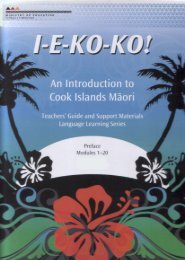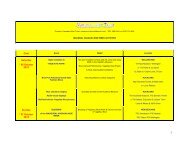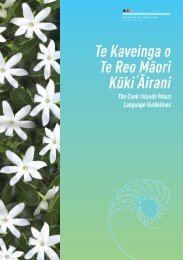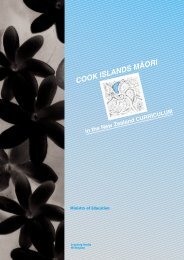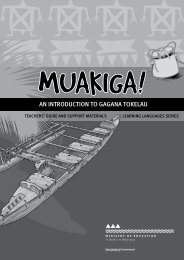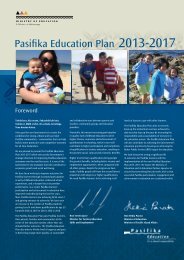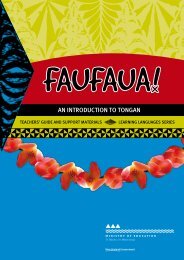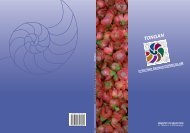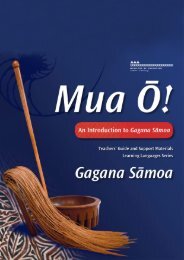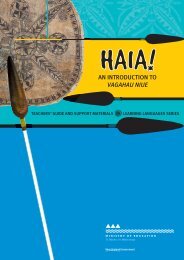Ta'iala mo le Gagana SÄmoa - Pasifika Education Community
Ta'iala mo le Gagana SÄmoa - Pasifika Education Community
Ta'iala mo le Gagana SÄmoa - Pasifika Education Community
Create successful ePaper yourself
Turn your PDF publications into a flip-book with our unique Google optimized e-Paper software.
Vāega 7: ‘O ni fa‘ata‘ita‘iga i <strong>le</strong> aganu‘u fa‘asā<strong>mo</strong>aLevel 7: Suggested aspects of fa‘asā<strong>mo</strong>aAt this <strong>le</strong>vel, <strong>le</strong>arning <strong>mo</strong>re about aganu‘u fa‘asā<strong>mo</strong>a involves focusing on and developing appropriate useof formal and informal language in a wide range of contexts. The degree of students’ sophistication inunderstanding aganu‘u fa‘asā<strong>mo</strong>a and how it relates to gagana Sā<strong>mo</strong>a depends partly on their previouslanguage experience and partly on the <strong>le</strong>arning activities that they take part in.The tab<strong>le</strong> below suggests possib<strong>le</strong> aspects of aganu‘u fa‘asā<strong>mo</strong>a for the Cultural Know<strong>le</strong>dge strandat <strong>le</strong>vel 7.Atamai i <strong>le</strong> Aganu‘uCultural Know<strong>le</strong>dgeStudents will:‘O ni fa‘ata‘ita‘iga i <strong>le</strong> aganu‘u fa‘asā<strong>mo</strong>aSuggested aspects of fa‘asā<strong>mo</strong>aStudents could be <strong>le</strong>arning through experiences that allowthem to:• de<strong>mo</strong>nstrate understanding of themeanings of particular culturalpractices;• interpret and respond to aspects ofsociocultural events in historical and<strong>mo</strong>dern contexts;• participate in composing andpresenting texts for particular events;• present gifts and make acknow<strong>le</strong>dgments at a funeral, forexamp<strong>le</strong>: Folafola sua o <strong>le</strong> maliu (public acknow<strong>le</strong>dgment ofgifts at a funeral). E fa‘atulou atu ‘i <strong>le</strong> pa‘ia o <strong>le</strong> maota osilagi.Faliu ia se silafaga i lau tōfā Va‘a. ‘Ou te tautala i <strong>le</strong> fa‘atupu‘ua ma‘ama‘au ‘i ai <strong>le</strong> afioga iā Faumuinā ma <strong>le</strong> fa<strong>le</strong>tua. ‘O laufa‘atamāli‘i <strong>le</strong>nei ‘o<strong>le</strong>‘ā ‘ou folafolaina atu …‘Ua iai <strong>le</strong> vailolo, ‘ua iai <strong>le</strong> fa‘avevela, ‘ua iai <strong>le</strong> ta‘apaepae.Fa‘alua lo‘u <strong>le</strong>o ‘ua iai <strong>le</strong> sua talisua ‘o <strong>le</strong> pusa pīsupo, ‘aeufita‘i i <strong>le</strong> ‘ie o <strong>le</strong> mālōFa‘afetai <strong>le</strong> teu, fa‘afetai <strong>le</strong> fa‘aaloalo;• make an acknow<strong>le</strong>dgment at the ava cere<strong>mo</strong>ny (sufi ava),for examp<strong>le</strong>:‘Ua pa‘ia <strong>le</strong> taeao ma <strong>le</strong> aso. ‘Ua mamalu fo‘i ‘auā ‘ua afio mai<strong>le</strong> pa‘ia o <strong>le</strong> faigāmalaga. E‘eta‘i maia <strong>le</strong>nā talā na ‘ātoa, ‘aese‘i liliu ane <strong>le</strong> laumua nei e sa‘ili se ‘ava <strong>mo</strong> lō tātou taeaofesilasilafa‘i;• use muāgagana (sayings) in appropriate ways, for examp<strong>le</strong>:E sui faiga‚‘ae tūmau <strong>le</strong> fa‘avae (Although conventions maychange, foundations remain);• identify <strong>mo</strong>dern changes to traditional conventions, forexamp<strong>le</strong>, by discussing changes to the sua in <strong>mo</strong>dern NewZealand;• use their know<strong>le</strong>dge of important aspects of presentation, forexamp<strong>le</strong>, e tāua te<strong>le</strong> vāega nei <strong>mo</strong> fa‘atinoga (the features ofa speech): <strong>le</strong> <strong>le</strong>o, tāga, fōliga, and lā‘ei;• ‘Ia talafeagai ma <strong>le</strong> gāluega ‘olo‘o fa‘atino (different kinds ofpresentations) for examp<strong>le</strong>: tautalaga; lāuga; fa‘atino se tala;fa‘atino se solo; siva; fa‘afiafiaga; pese; fa‘asalalauga;• compose and present various types of written texts, forexamp<strong>le</strong>, different kinds of tusitusiga, such as tala fou <strong>mo</strong> <strong>le</strong>nusipepa/<strong>le</strong>itio, fa‘asalalauga, tusigātala, tusi vala‘aulia, talafa‘atino, and ‘upu o pese/solo;89



